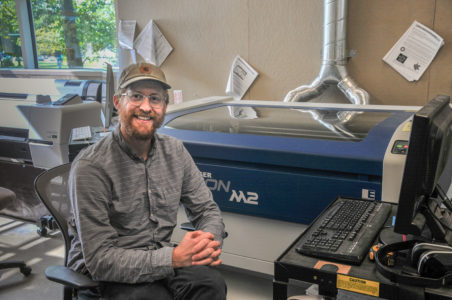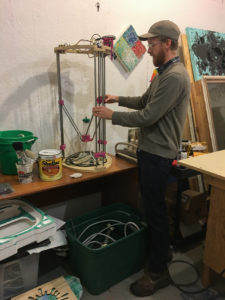
When Grin City Collective, a local arts group, transitioned from an artist residency program to focusing on public art, it left the Lacina family farm on Highway 146. The property’s use as a space of art-making, however, did not leave with it. Joe Lacina, who founded Grin City, continues to live on the farm and make artwork, including sculptures, paintings and interior spaces. He also serves as the College’s studio art technician, assisting the department with purchasing, managing student workers and safety demos, as well as coordinating the Smith Gallery.
Growing up in Grinnell, Lacina was always the “art kid,” and making art was always encouraged in his family. His mother has a ceramics area furnished with two kilns, and the woodshop Lacina uses today was his grandfather’s. While Lacina has made his own contributions to the organizational setup of the shop, much of what is now in the shop was put there by his grandfather, such as a wall of boxes with different sized dowels and bolts and some cut-out comics to lighten the atmosphere.
After graduating from Grinnell High School, Lacina went to Baltimore, where he studied painting at the Maryland Institute College of Art. He then moved to Philadelphia, where he ran an art gallery. Eventually, he moved back home to his family’s farm to turn a space that had been used as a summer artmaking place for Lacina and his friends into a nonprofit artist residency program.
Eventually, however, Lacina decided to pivot from Grin City to graduate school at the University of Iowa, where he studied sculpture.
A lot of Lacina’s art is at least part sculpture, much of it being functional spaces and items, as well as non-functional sculptures and paintings. Some of his pieces have kinetic aspects as well, ranging from pulsing air muscles mimicking a heartbeat or a breath, to a small piece of sandpaper, tapping away at a wooden canvas. He makes some abstract sculptures, but he’s also made a couple of bikes.
Walking through his studio building, one passes by a number of rooms. Lacina makes interior spaces, including the third iteration of Lacina’s cocktail lounge, which, he said, “gets a little better each time.” It is currently decorated with a “Happy Birthday” banner, along with its usual setup.
“You can see I have some of those geodesic foam structures on the ceiling. They kind of diffuse the light and you get kind of a cathedral, almost like stained glass effect on the walls,” Lacina said. “There’s also a chip rack, you know, every bar has to have a chip rack. I feel like that’s important.”
In Lacina’s studio, where he creates most of his artwork, he is working on a piece based on a splat painting he saw on a British television show, Grand Designs.
“I was like, I want that, and I decided to just make it and make it shinier,” Lacina said. “And that’s not even that shiny — there’s a coating on here and once I peel that off it’ll be super glossy.”
Also in his studio he has a homemade 3D printer, which, to build, required an already-made, regular 3D printer.
“Where do you start? It’s like the chicken or the egg,” Lacina said.
Walking across the family farm, the functionality of Lacina’s art becomes apparent—handmade wooden structures continuously crop up. He points out a wooden swing on the front porch of his house, a “cat house” and a chicken coop, all of which he built.
The “cat house” is a structure made of cedar, with two levels and a four-layer glass pane (one cat, Luna, hopped right on in as we stood there). The thick walls and insulation foam that Lacina included keep the two cats, Luna and Louis, warm during the cold Iowa winters.
“The chickens really like cat food, and the cat food has chicken in it. They don’t care, they’re dinosaurs, they would definitely eat a chicken. Chickens eat chicken. They love chicken, it’s just something that they do.”
Chicken coops are more complex than one might think, showing the preciseness and complexity of Lacina’s craft.
“There are lots of little hatches and doors and compartments and things you need to do to keep predators out. Like, you need this specific hardware cloth so that predators can’t get through and pull chickens up to the fence. You have to bury it eight inches around the perimeter,” Lacina said. “And there’s certain things you have to do as far as venting, and then how light works in the chicken coop, you have to have the laying boxes under the window but they can’t be able to see out of the window or else they won’t make many eggs, or something.”
Lacina intends to continue moving in the direction of making functional art. However, he’d only do it with his own twist. His most recent lamp is ornamented with cat hair.





































































